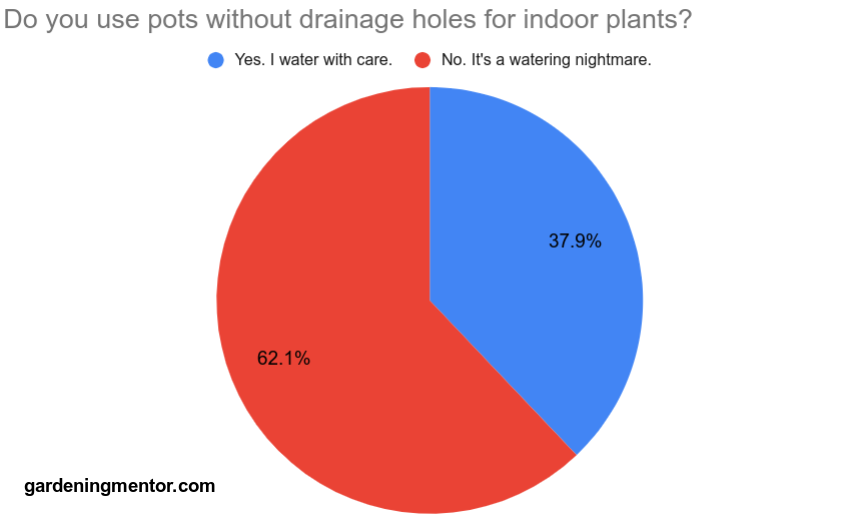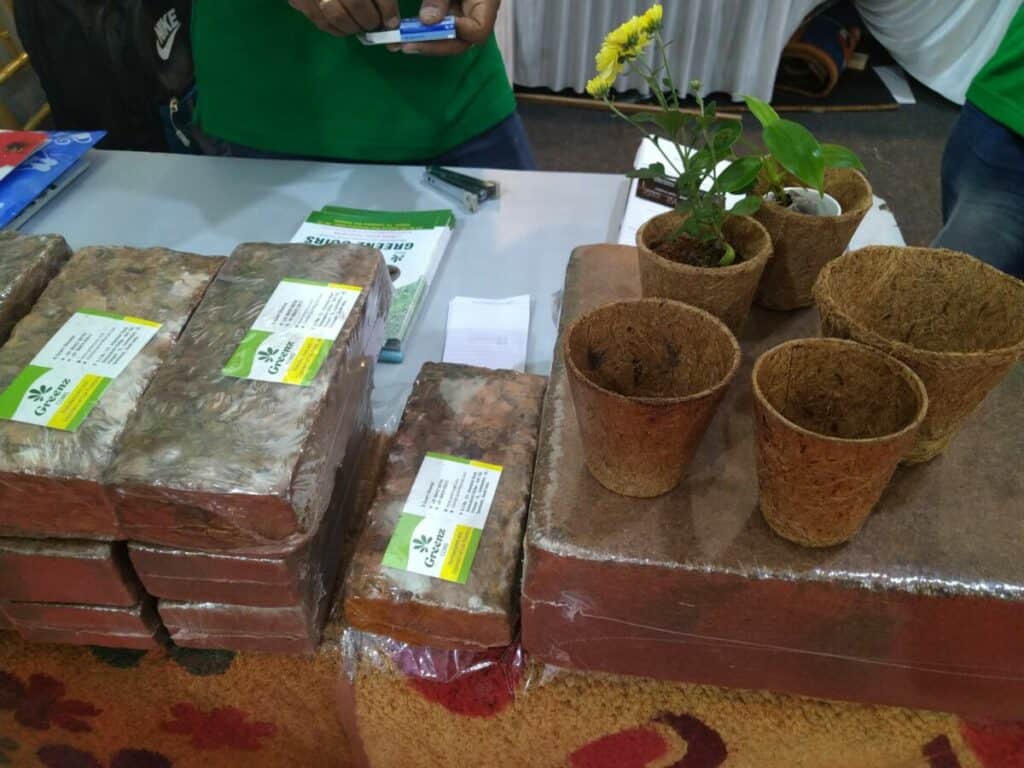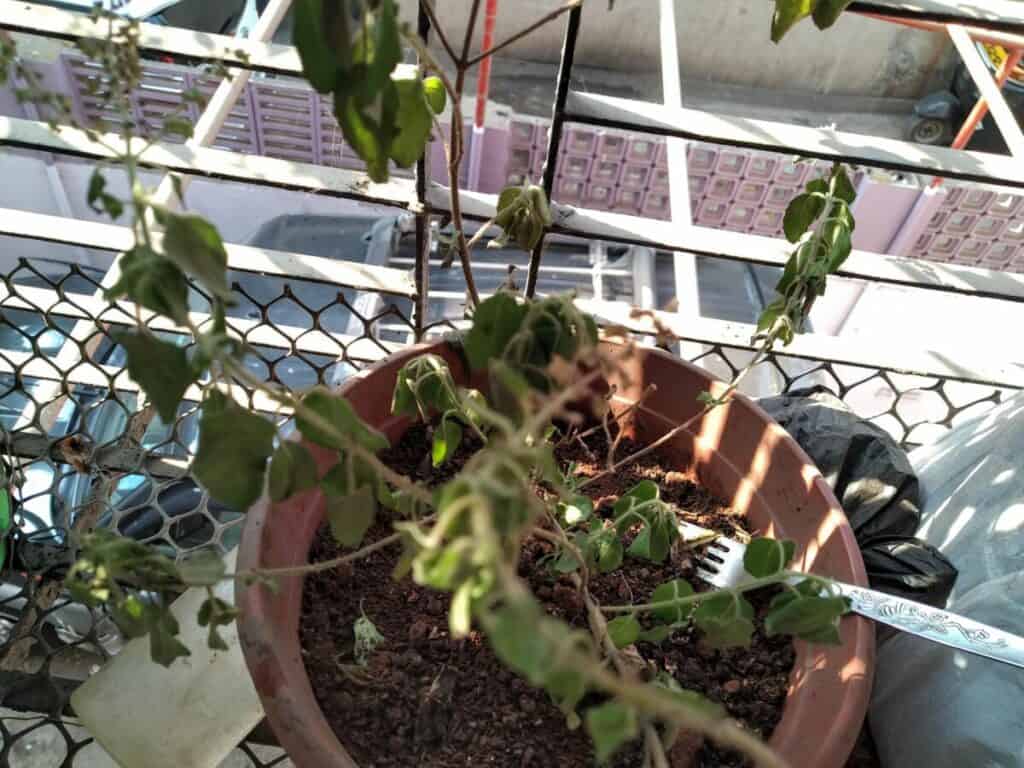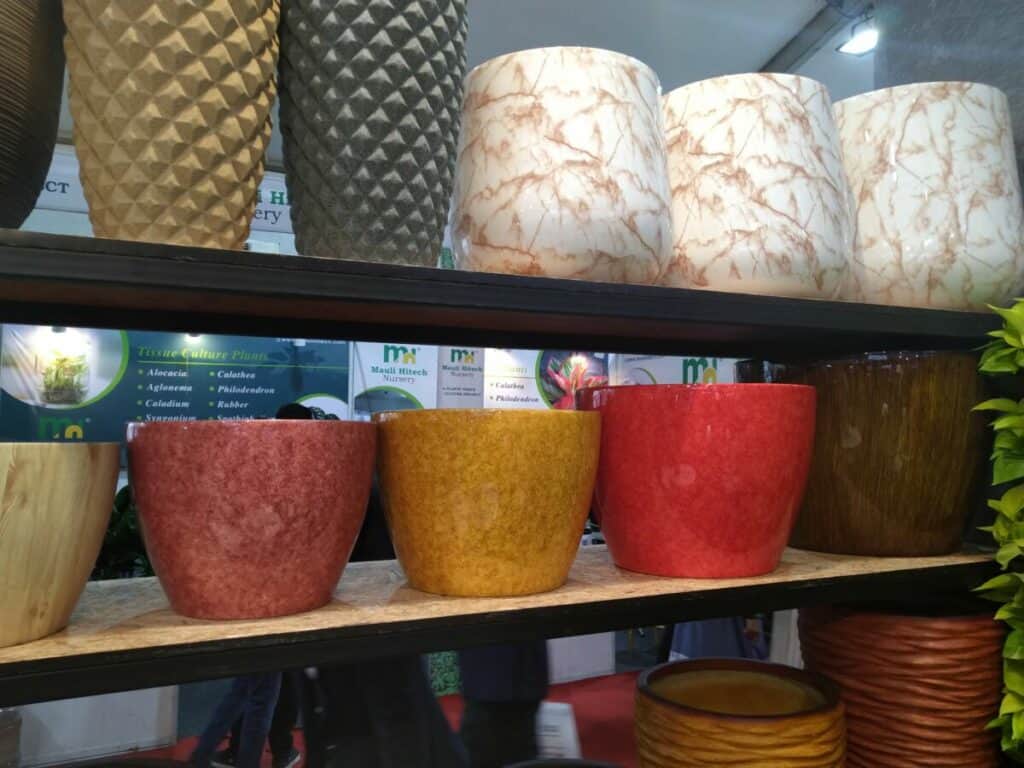You got some pots at home and want to grow some plants in them. But the problem is they don’t have drainage holes at the bottom. So would you be able to grow plants in them?
You can put plants in pots without drainage holes but you need to be careful with watering the plants. You want to prevent water from remaining in the pot for long that causes overwatering and issues like root rot. You need to put just the right water so it does not collect at the bottom.
If you still want to grow plants in such pots without holes, I’ll help you with the steps. I’ll also give you a list of plants that don’t mind growing in such pots as long as you’re careful with them.
What are the problems in pots without holes?
Overwatering
We have already seen that the most significant problem plants can face is overwatering. The excess water cannot flow out of the drainage holes and will remain in the pot.
Overwatering will cause fungal diseases such as root rot that will damage the roots and kill the plant.
I really don’t like pots without holes unless they are the “cover pot” of something. I almost always end up doing holes myself if I really like the pot. I have way too many plants to be doing weird math for avoiding overwatering a plant with no drainage. – Lucy
Buildup of salt
When you grow plants, you will add fertilizer to the potting soil. The roots will absorb the nutrients from the fertilizer, but some salt may be left in the potting soil.
As you keep adding fertilizer over the growing season, the amount of salts in the potting soil can increase, making it toxic.
If the salt content is very high, the roots are unable to figure out they need moisture. This leads to the plant getting dehydrated and face issues of underwatering.
The leaves will start to turn dry and droop because of a lack of moisture. This will stunt the plant growth, and the plant may die.
When you water the potting soil, this excess salt tends to drain out from the drainage holes. But since your pots don’t have these holes, the salt will remain in the potting soil causing the above problems.
Reduced aeration
If the pot has drainage holes, the potting soil can absorb oxygen from them. If you use a pot without drainage holes, the potting soil and roots can only get oxygen from the top. So it’s vital not to overwater the potting soil as that will block this aeration.
What are the benefits of using pots without holes?
Cleanliness
The biggest benefit of using pots without holes for indoor plants is that the water will not flow out and stain the floor.
The potting soil cannot leach out from the drainage holes and make a mess in your house.
Less work
If you have a pot without drainage holes and won’t be making any, it saves you effort. It can take some effort to make such holes in terracotta, ceramic, wood, metal, or concrete pots. It might be easier to create these holes in plastic pots.

If you’re looking to create drainage holes in pots, I recommend reading my post. This will help you find out how many drainage holes you should drill and what method you can use to drill them.
You also won’t need to fertilize as often because the nutrients will remain in the potting soil longer. They cannot leach out of the drainage holes along with the water.
Selection of pots
If you try to get pots with drainage holes, you will be limited in choice. But if you can pick any pot, including those that don’t have drainage holes, you can get many varieties.
Since these pots are not limited to gardening use, you can get several shapes and patterns that improve your house’s look.
I conducted a survey asking gardeners if they used pots without drainage holes for their indoor plants. 62.1% mentioned that they prefer to avoid such pots so watering is easier.

How to plant in pots without drainage holes
The most important thing to do is ensure that any excess water gets some space to stay at the bottom of the pot without touching the roots.
1 Place a layer of stones
Add some stones, pieces of bricks, or pieces of clay pots to the bottom of the pot without drainage holes. You can add this layer of about 1/2 inch height which helps to keep some of the excess water at the bottom.
2 Place a layer of organic matter
The next layer to add on top of the stones is some organic matter. I would recommend using dried leaves, coco coir, or hay as this layer. Add 1/4-1/2 inch of this layer which helps soak up the moisture and transfer it to the lower part of the pot.

3 Place a layer of charcoal
The next layer you can add on top of the organic material is a layer of small pieces of charcoal. This will help absorb excess moisture from the potting soil and push it to the lower parts of the pot. You can add such a layer that is 1/4 to 1/2 inch in height.
4 Add good potting soil
The final step is to fill the pot with good potting soil. This soil should have the right texture, so it stores enough moisture but drains out the excess.
You can get this from a store or make it yourself as you’ll have better control over the materials. You can mix 2 parts of garden soil with 1 part coco peat and 1 part compost to get a good potting soil mix.
Make sure to add the potting soil till it almost reaches the top of the pot but leave about 1-2 inches from the top. This will help prevent water and potting soil from spilling out when watering.
How do you water plants in pots without drainage holes?
I hope I’ve already made it clear you need to be really careful when watering plants in such pots without drainage holes. You want to provide just the right amount of water that is not too little nor too much.
If it’s too little, the plants may face underwatering, and if it’s too much, the plant may face overwatering. Both problems can cause problems to the plants, and they may die in the worst case.
It’s best to use a watering bottle with a narrow mouth to water such plants. This will give much better control over the watering than using a regular watering can.

First, you should find out if the plant needs watering. The simplest way to do this is to stick your finger 1-2 inches into the potting soil and check for moisture.
If the tip of your finger comes out dry, it means you need to give the potting soil some water.
Since you’re growing plants in a pot without drainage holes and need extra care, you can even use a moisture meter that you stick into the potting soil. This will tell you exactly how much moisture is present in the potting soil. Which helps understand whether you should water or not.
The moisture meter will also help protect your potted plants from overwatering because you will not add more water than is needed.
You can water exactly near the base of the plant and provide just the required amount of water. You can measure the amount of water the plant needs when you water it the first couple of times.
You then can provide the same amount every time you water without worrying about overwatering or underwatering. You can get a rough idea by measuring how much water you poured into the watering bottle in cups.
If you use a container that is made of glass and transparent, you’ll be able to see exactly how much water has reached the potting soil and bottom of the container.
If you find excess water in the potting soil, you could pour it out in the sink. You need to carefully hold the base of the plant and tilt the pot over the sink, so the water flows out into the drain.
What plants can grow in pots without drainage holes?
I would not recommend growing outdoor plants in pots without drainage holes. This is because it can rain outdoors and flood your pots.
These pots are suitable for growing indoor plants that you can monitor and control how much water the plants receive.
I use ones with no drainage holes for my pothos plants because they don’t get watered too often but most other plants get holes. – Jennifer
You can also grow plants that are hardy and easy to care for. You want to grow plants that don’t require watering as often. And they are OK if they receive a little less water.
Here’s a list of hardy houseplants and would grow fine in such pots without drainage holes.
- Spider plants
- Philodendrons
- Peace lilies
- Begonia
- Ferns
- Cacti
- Moss
- Snake plant
- Chinese Evergreen
- Crotons
- Oleander plant
- Pothos
- Schefflera
- Succulents
What are some alternatives to use pots without drainage holes?
You can use some alternatives that will give you the benefits of using pots without drainage holes but not the problems of overwatering.
Self-watering pot
A self-watering pot is built specifically for growing plants. This pot does not have drainage holes but uses the method of bottom-watering instead.
A reservoir at the bottom of the pot is separated from the top, where you add the potting soil. Both sections are connected with a wick.
You add water to the reservoir, and the moisture reaches the potting soil through the wick.
Almost all of mine are in self-watering pots. Once I get them filled I can get away with only 2 gallons of water most days. – Daria
The benefit of using a self-watering pot is that you don’t need to always water the plant. You can fill the reservoir, and it will last for a few days as the potting soil absorbs the moisture.
Many self-watering pots also have an indicator that will show you the water levels, so you know when you need to fill the reservoir again.
You can get a self-watering pot in different sizes, so it should be suitable to grow most houseplants.
Cachepot
This method may look a little bit like cheating because you will need a pot with drainage holes. You will add the potting soil and grow the plant in this pot.
However, you will not place this pot in your house. You will place this pot in a larger pot that can hold it. The larger pot will not have any drainage holes, and we call this the cachepot.
This way, you get the benefit of using a pot without drainage holes. The water flowing out from the drainage holes of the smaller pot will collect in the larger pot and not stain the floors. You can remove the smaller pot and throw the water that is collected.
I do have pots without holes but I end up just putting a plant that is already in another pot with holes inside of it to bottom water. – Jessica
You could also take the smaller pot out of the cachepot and water the plant in the sink. This way, you don’t need to worry about water on your floor or inside the cachepot.
You also get to select a wide variety of ceramic or wood pots that you could use as the cachepot. So you could use a plastic pot to grow the plant and place it inside a ceramic cachepot. This will give a much better look to the house than directly using the plastic pot.


Fact Checked, Written, and Published by Kevin Rodrigues
Kevin is the founder of Gardening Mentor, a website that aims to teach people to grow their own food in a limited space. As a self-taught gardener, Kevin has spent several years growing plants and creating gardening content on the website. He is certified in Home Horticulture and Organic Gardening from Oregon State University. He has a Post Graduate Diploma in Horticulture and Landscape Gardening from Mumbai University.
Read more
